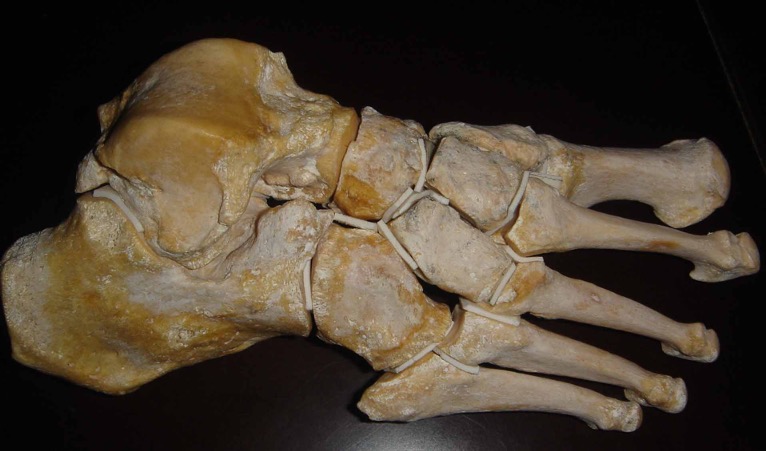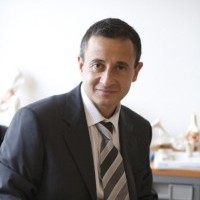Which symptoms may lead to surgery? What are the symptoms not to take in account?
Traditionally, surgery for the correction of forefoot deformities has a bad reputation, due to peri-opertive pain, surgical imperfections, sequelae and risk of recurrence. A large part of these failures are not linked to the technical realisation but to errors in the surgical indications. Indeed, facing a patient, it is important to analyze the nature of pain and expectations, in order to suggest an adapted correction procedure. It is necessary to refuse to operate a harassing patient without symptoms, to protect him against himself.
Symptoms to take into account
With a visible deformation, the only parameters leading to a surgical proposal are, according to us, exclusively the following: pain, discomfort in footwear, and handicap in the everyday life. Assessing these symptoms is harsh because they are highly subjective, which needs to be taken into account.
Pain can be described ranging from an single occasional crisis to a disabling and permanent trouble.
Discomfort in footwear can either be just temporary when wearing narrow shoes for an occasion, or lived like an endless marathon when trying to buy a new pair of shoes.
Handicap felt in the everyday life tells more objectively the consequences of the pathology, that can for instance prevent the patient from going out with his family in social and playful activities. This fear of being dragged in the usual life is constituting a moral suffering.
Therefore, the surgeon’s analysis is based on the evaluation of these parameters. If he is capable to erase the invoked symptoms, he shall propose an intervention. If the intervention cannot erase them, it is his responsibility not to. Indeed the aim is not to restore a “normal” foot, but make it functional that is to say capable of performing the desired function.
Symptoms not to take into account
Some parameters may prevent from decision surgery, especially if they are isolated from the previous criteria.
Preventive surgery
One must not have surgery without symptoms, even under the pretext they could appear one day. The surgeon has to resist to the long and fastidious litany of the enumeration of the ascendant victims of the same pathology: the sister, the mother, the grand-mother, etc. According to the patient, the presence of the same trouble, even at minimum, assigns his destiny irreversibly… The patient has to manage his stress, and understand the deformation isn’t necessarily going to grow with time. If an unfavourable evolution occurs, it won’t happen all of a sudden, and the patient will not wake up one morning with a witch’s foot. Operating a patient without symptoms exposes the risk of creating painful and irreversible sequelae, since we are changing an architecture that suited.
However, this statement has to be moderated for a patient with associated risks (diabetes for example) whose deformation exposes him to severe complications, even if the symptoms are a little intense. They could even be unknown as a neurological pathology minimize them.
Plastic surgery
Requesting plastic surgery in the consultation comes more or less frankly. This point has to be taken into account without value judgment, but the esthetical dimension should in no way constitute the main and/or the exclusive motivation for surgery, nor interfere in the decision-making. It is important to recall that surgery, via bone cuts performed, changes the foot architecture. If the foot is, at the beginning, harmless, the architecture changing has important risks to generate irreversible pain.
Other criteria to be assessed case by case
They do not constitute real contraindications but their existence may engender harder operative follow-up.
Exaggerated complaints
“I live with bandages since I’m 12”, or “I’ve been waiting this operation since childhood” are examples that must lead us to be very cautious in the surgery proposal. The surgeon must decode what the patient expresses, that may probably not be summed up to the only foot deformation.
Complaint linked to the working conditions
In this case, the patient’s talk is essentially focused on his grievances about working constraints (obligation to wear safety shoes, schedule difficulties, etc…). These situations have to be detected because the perception of the functional result must never depend on professional issues that the scalpel’s blade cannot erase.
Inadequate or even totally false convictions
The use of screws or other type of implants to fix bones during surgery is sometimes experiences by the patient as an element of gravity. Even if it is a common situation but essential for the surgeon to decrease the failure risks, “having a screw in the foot” may become psychologically insurmountable for some patients. However, the presence of foreign bodies is perfectly well accepted when it is about two large breast prostheses, dental implants, an IUD, or digestive suture staples…
Others see percutaneous surgery as a consumer good, a fashion accessory, more than a surgical act. They imagine magical possibilities of “laser” acts that do not exist. The gap between fantasy and the post-operative reality has heavy consequences. During the preoperative step, if the practitioner doesn’t achieve to correct the false beliefs, the surgery seems jeopardized.
The pathology does also change with time, which the patient has to understand. If he thinks he can get rid of all his future problems thanks to surgery, he is wrong, and cautions should be taken.
The surgeon has to be cautious again in front of an unjustified request for a bilateral intervention, with a patient not listening to the arguments pleading against.
In summary, facing wrong convictions that the surgeon cannot make evolve, when an irrelevant detail of the procedure hides the entire field of consciousness, it is wise to renounce.
Extravagant requirements for footwear
The question is not to assess the relevance of the desire but to evaluate the real patient’s expectations and thus estimate if we are capable or not to respond. The more the patient is demanding in terms of footwear, the more it is difficult to reach the aim, and the higher is the risk of disappointment.
Expectable post-operative non-compliance
It concerns the patient’s inability to follow the prescriptions, to respect the weight-bearing instructions, to react if his rehabilitation is poor, etc. Since the purpose of the intervention is to improve the patient’s function, failure is expectable in case of post-operative non-compliance. It’s therefore necessary to render him the great service not to operate him. This non-compliance, often spotted before the operation, may occur because of heavy constraints in the private and professional life, or either in personalities not prone to follow the instructions. It might also also happen in case of hygiene or obvious care issues in the initial presentation of the patient.
Conclusion
The surgeon’s work consists certainly in realising a technically perfect surgical operation, but mostly to identify, by the right symptoms, the patients that will benefit from their intervention.


